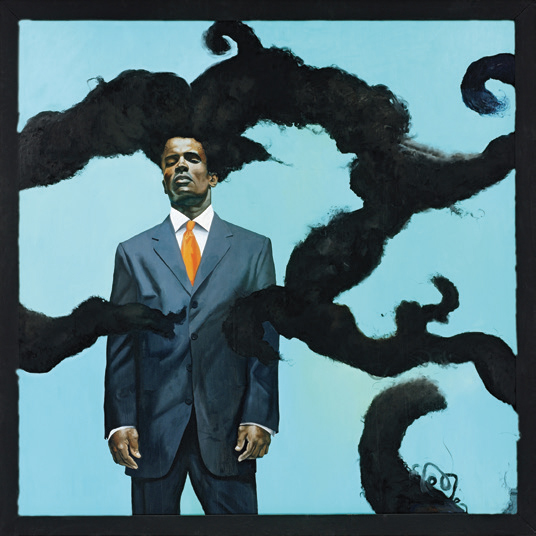Black Refractions
Smith College Museum of Art • Northampton, MA • scma.smith.edu • January 17–April 12, 2020

His feet are planted firmly on the ground, his legs straddling a bicycle outside the Adam Clayton Powell Jr. State Office Building in Harlem. Yet the vibrant flying objects surrounding the man in Jordan Casteel’s Kevin the Kiteman convey a sense of elevation that transcends the mere act of steering a kite. Set against a concrete background, their patterned vibrancy suggests an exaltation of spirit. “From my perch in the studios, I often spent time looking out at the Adam Clayton Powell courtyard…There was one man who often caught my eye,” Casteel said, according to The Studio Museum in Harlem’s website. “He would be in the courtyard across the street clearly having the time of his life dancing and flying kites.”
Casteel was an artist-in-residence at The Studio Museum from 2015–2016, and this painting is just one of the many outstanding works in the seminal and wide-ranging exhibition Black Refractions: Highlights from The Studio Museum in Harlem at the Smith College Museum of Art (SCMA). Organized by The Studio Museum and the American Federation of Arts, this traveling exhibition examines The Studio Museum’s crucial role in the creation and display of black artists’ work since its 1968 founding. One of the show’s five sections is devoted to its artist-in-residence program, which provides emerging artists from any media with an 11-month studio residency. Included in this section are works by such contemporary titans as Kerry James Marshall, Chakaia Booker and Titus Kaphar.
In other sections, Beauford Delaney, Alma Thomas and James VanDerZee are among the nearly 80 artists included. One of those segments, “Their Own Harlems,” explores how the Manhattan neighborhood has influenced artists’ work for the past century. Another, “Founders,” focuses on artist activists in the years preceding the museum’s opening.
Emma Chubb, SCMA’s curator of contemporary art, noted that The Studio Museum’s founding offered inclusivity at a time when black artists were underrepresented at contemporary art museums, a problem still in need of fixing. The museum’s artist-in-residence program has helped raise profiles. “You can see the ways in which the residency has really been pivotal to bringing these artists the attention they deserve, and also supporting them,” Chubb said.
